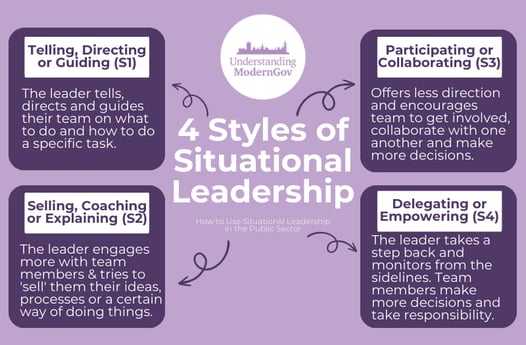How to Use Situational Leadership in the Public Sector | Tips & Expert Advice
 Chloe Martin
·
8 minute read
Chloe Martin
·
8 minute read
Public sector leaders are under more pressure than ever before.
Having to adapt to constant changes, build trust within teams and drive quicker results, could your current leadership style be holding you back?
The solution may be Situational Leadership.
This post covers what situational leadership is, how it can be used in the public sector, why it’s important, examples and how to implement it in the workplace.
Plus, for expert insights, we spoke to Executive Coach and Mentor, Kate Sturdy, who has 20 years of senior leadership and management experience in local government, the private sector and the UK Civil Service.
Let's get started...
Contents:
- What is Situational Leadership?
- What is the Situational Leadership Theory?
- 4 Styles of Situational Leadership
- Key Characteristics and Skills of a Situational Leader
- Situational Vs. Behavioural Leadership
- Why is Situational Leadership Important?
- 4 Examples of Situational Leadership in the Workplace
- How to Use Situational Leadership in the Public Sector
- How to Develop Situational Leadership Skills | 5 Tips
- What is Situational Leadership Training?
What is Situational Leadership?
“All leadership is about balancing who you are, who you are with and the situation you’re in.” - Kate Sturdy
Situational Leadership is a dynamic and adaptable approach to leadership that emphasises adjusting your style based on the specific situation. By being aware of different situations, team needs and factors that may contribute to reaching the goals, Situational Leaders choose what's best depending on the situation, who's involved and the task at hand.
It's important in the public sector as it enables leaders to effectively respond to the complex and changing demands of their roles.
By developing Situational Leadership skills, leaders can enhance their ability to adapt, thrive and achieve results in any situation they come across.
What is the Situational Leadership Theory? Hersey and Blanchard’s Model
"A theory that no single leadership style is better than another."
When it comes to Situational Leadership, there isn’t a one-size-fits-all approach. Hersey and Blanchard's Situational Leadership model recognises that every leader has their own individual style of way of learning and guiding depending on unique circumstances.
Hersey and Blanchard's model suggests that a leader should change their leadership style to match the development of their followers (employees) to help them become more independent.
There are 4 main elements that Hersey and Blanchard's Situational Leadership model depends on:
- The developmental level of the team members
- Adaptability of the leader
- Communication with team members
- Achieving group targets
4 Styles of Situational Leadership
Hersey and Blanchard's model also introduced 4 main styles of Situational Leadership...
1. Telling, Directing or Guiding (S1)
The leader tells, directs and guides their team on what to do and how to do a specific task.
2. Selling, Coaching or Explaining (S2)
In this leadership style, the leader engages more with their team members and tries to 'sell' them their ideas, processes or a certain way of doing things.
3. Participating, Collaborating or Facilitating (S3)
This leadership style offers less direction and encourages team members to get involved, collaborate with one another and make more decisions.
4. Delegating, Empowering or Monitoring (S4)
As a hands-off approach, this style of leadership takes a step back and monitors from the sidelines. Team members make the majority of decisions and take responsibility for what happens after those decisions are made.
Key Characteristics and Skills of a Situational Leader
-
Courage: Situational leaders are not afraid to make changes and decisions to drive a project forward.
-
Adaptability: Being a situational leader means you change your leadership style depending on the needs of the situation and task at hand.
-
Delegation: From daily activities to large projects, a situational leader will focus more on goals rather than the tasks needed to be done to meet them.
-
Curiosity: Be curious about yourself, what you are doing and about your teams and how they respond to you.
-
A Clear Sense of Direction: Every situational leader needs a vision and clear goals in place for the team to achieve.
-
Active listening: To understand situations and how to deal with them, the most important element is to listen. Engage with situations and employees to understand the best route to take.
Situational vs. Behavioural Leadership
Situational Leadership is a leadership approach that emphasises adapting and adjusting your leadership style based on the specific situation and context at hand.
Whereas, behavioural leadership focuses on the actions and behaviours to lead a team, instead of their skills and characteristics.
One disadvantage of behavioural leadership in comparison to Situational Leadership, is that one behaviour or action may be effective in one situation, but not in another.
Why is Situational Leadership Important?
Situational leadership is important because it allows leaders to adapt their approach based on the specific needs of each situation and individual. This flexibility is crucial in today's rapidly changing and complex work environment. Here are three key reasons why situational leadership is important in the public sector:
1. Enhances decision-making: Situational leaders have the ability to assess the current situation, consider the capabilities and readiness of their team members and make informed decisions accordingly.
By tailoring their leadership style to the specific needs of the situation, leaders can ensure that their decisions are effective and aligned with the goals of the organisation.
2. Maximises employee development: By understanding the strengths, weaknesses and developmental needs of each team member, leaders can provide the right level of support and guidance to help them grow and succeed. This approach not only enhances employee satisfaction and engagement but also contributes to the overall success of the team.
3. Promotes effective communication: Situational leadership encourages open and effective communication between leaders and their team members. By actively listening and engaging with employees, situational leaders can gain valuable insights into the challenges they face and the support they need.
This fosters a collaborative and inclusive work environment where everyone feels heard and valued, leading to improved teamwork and problem-solving.
Cons of Situational Leadership
There are disadvantages to every leadership style, here are three that can be a con of situational leadership:
- It can create confusion: Consistency in leadership style and communication is crucial to avoid confusion among employees. When leaders constantly change their approach, it can be challenging for employees to understand how to work with them and adapt to their leadership style.
- Potential for misalignment between actions and expectations: The perspective of a leader on a situation and their response may vary from that of a team member. This can not only create confusion but also misalign the leader's values. If this happens repeatedly in the long term, team members may lose trust and take more matters into their own hands if they're unhappy.
- Reliance on the leader: On the other hand of potential misalignment, too much reliance on the leader's decisions and actions can also be a disadvantage of Situational Leadership. Team members must be able to take initiative, and understand situations and what their role entails without relying too much on their leader for guidance.
4 Examples of Situational Leadership in the Workplace
Situational Leadership is a versatile approach that can be applied in various workplace scenarios. Here are four examples of how Situational Leadership can be effectively used in line with the four main styles highlighted above:
1. New Employee Onboarding
When a new employee joins the team, they are likely to need more guidance and direction. In this situation, a leader can adopt a telling or directing style (S1) to provide clear instructions and expectations.
By taking a hands-on approach, the leader helps the employee understand their role, learn new tasks and integrate into the team.
2. Crisis Management
During times of crisis or emergencies, leaders often need to make quick decisions and provide clear direction to their team members. This calls for a telling or guiding style (S1) where the leader takes charge and provides step-by-step instructions on how to handle the situation.
By taking decisive action and providing guidance, the leader instils confidence in their team and helps them navigate through the crisis.
3. Team Collaboration
In situations where a team is working on a complex project or problem-solving task, a leader can adopt a participating or facilitating style (S3). This approach encourages team members to actively participate, collaborate and contribute their ideas and expertise. This style promotes teamwork, creativity and innovation.
4. High-performing Team
When leading a team that is already highly skilled and motivated, a leader can adopt a delegating or empowering style (S4). In this situation, the leader takes a step back and allows team members to take ownership of their tasks and make decisions independently.
The leader provides support and resources when needed but trusts the team's abilities to achieve the desired outcomes. This style empowers team members, fosters autonomy, and promotes a sense of ownership and accountability.
How to Use Situational Leadership in the Public Sector | Q&A With Kate
Public sector leaders have a lot on their plate. Kate explains that “public sector leadership demands great attention to task and delivery focus combined with deep and effective people engagement – with your team, your delivery partners, your customers."
How Can Public Sector Leaders Use Situational Leadership to Meet Everyday Demands?
Kate told us how. Take this example to illustrate:
"Developing a new hybrid working policy for your organisation involves bringing together all four classic situational leadership styles of telling, selling, participating and delegating.
- You will need to tell your team the parameters of the task that the Board have agreed on and clarify points of detail.
- You will sell the project to your team creating buy-in and understanding, giving team members space to debate, discuss and contribute.
- You will participate alongside team members to make sure they all feel aligned with the project.
- And you will delegate by extending autonomy to individual team members.”
This is just one example of how Situational Leadership can be effective for public sector leaders.
Why is it Important for the Public Sector to Use Situational Leadership?
"In the public sector, leaders learn to expect the unexpected. Many senior roles are affected by the shifting political climate – and leaders have become used to leading in a VUCA world – of volatility, uncertainty, complexity and ambiguity.
Being able to adapt to the situation you are facing is essential. If a news story blows up overnight affecting your project – be it vaccine roll-out, benefits policy, local elderly care etc.. – it will impact your team, and any leader needs to be able to respond, adapt, re-engage and re-set the direction."
How to Develop Situational Leadership Skills | 5 Tips
1. Learn More About Your Team
A crucial skill for a Situational Leader is the capability to assess the strengths and weaknesses of team members. This analysis empowers leaders to determine the most effective response in specific situations. This helps you understand how to take appropriate actions or guide your team accordingly.
2. Observe Others' Leadership
To gain insights into how to navigate various situations, observe and study the techniques and outcomes of other leaders in your surroundings. If you're looking for a more personalised approach, try one-to-one coaching or speak to others outside of your organisation for a wider view.
3. Work on Your Problem-Solving Skills
Your ability to react, adjust your leadership style appropriately and take action in various situations will come from your ability to problem-solve, and fast. From resolving conflicts between team members to having to make difficult decisions without all the right information, practice viewing all potential solutions and thinking critically about them all.
4. Try out Different Leadership Styles
It can be hard to know what leadership style to use and when or how to use it effectively, especially if it's a new style altogether. Kate says: "Sharing your intent with a team member, boss or coach can help you try out new approaches and reflect on what went well and what you'd like to change next time."
5. Invest in Situational Leadership Training
Situational Leadership training is designed to develop your understanding of different elements of various leadership styles and how or when to emphasise each of them.
What is Situational Leadership Training?
Whether you don’t know your leadership style or you’re unsure how to improve to adapt to any situation, attending Situational Leadership training is a great opportunity to take the time to think about how you lead your team.
Our Situational Leadership training course is designed to help you understand the theory behind Situational Leadership through interactive exercises and you’ll also gain expert advice on how to choose the techniques that suit you.
Key Learning Objectives:
- Understand and apply the Situational Leadership technique
- Deep dive into the various Situational Leadership models
- Adopt a leadership approach that suits you best
Kate explained why Situational Leadership training is so important for public sector professionals:
“Public sector leaders are under great pressure to deliver and achieve results – often by reducing time and effort spent on essential people engagement. So, picking up techniques to reset your balance will help you respond even more effectively to future leadership challenges.”
Learn How to Adapt and Thrive in any Situation as a Leader
Gain the tools and techniques you need to implement a leadership approach that suits you on our upcoming Situational Leadership training course.
2+ years in SEO and content marketing. Striving to help public sector professionals develop their skills and learn something new through high-quality content.


-2.jpg?width=800&height=525&name=2%20(2)-2.jpg)







